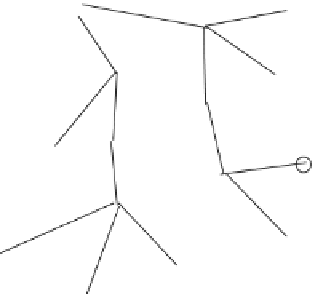Image Processing Reference
In-Depth Information
FIGURE .
Aggregating data in a sensor network.
10.6 Secure Data Aggregation
As already mentioned in the introduction, data from different sensors is supposed to be aggre-
gated on its way toward the base station (see also Figure .). This raises the two questions, how
to ensure authenticity and integrity of aggregated data, and how to ensure confidentiality of data to
be aggregated? Concerning authentication and integrity of data reported toward the base station,
if every sensor would add an MAC to its answer to ensure data origin authentication, all (answer,
MAC)-tuples would have to be sent to the base station to enable checking of the authenticity. This
shows that individual MACs are not suitable for data aggregation. However, if only the aggregating
node added one MAC, a subverted node could send arbitrary data regardless of the data sent by
sensors.
At GlobeCom', Du et al. proposed a scheme [DDHVb] that allows a base station to “check
the integrity” of an aggregated value based on endorsements provided by so-called witness nodes.
The basic idea of this scheme is that multiple nodes perform data aggregation and compute an MAC
over their result. his requires individual keys between each node and the base station. To allow for
aggregated sending of data, some nodes act as so-called data fusion nodes, aggregating sensor data
and sending it toward the base station. As a data fusion node could be a subverted or malicious node,
its result needs to be endorsed by witness nodes. For this, neighboring nodes receiving the same
sensorreadingscomputetheirownaggregatedresult,computeanMACoverthisresultandsendit
to the data fusion node. The data fusion node computes an MAC over its own result and sends it
together with all received MACs to the base station. Figure . illustrates this approach.
In more detail, the scheme is described in Ref. [DDHVb] as follows:
•
Sensor nodes
S
,
S
, ...,
S
n
collect data from their environment and make binary decisions
b
,
b
, ...,
b
n
(e.g., fire detected) based on some detection rules.
•
Every sensor node sends its decision to the data fusion node
F
,whichcomputesan
aggregated decision
SF
.
•
Neighboring witness nodes
w
,
w
, ...,
w
m
also receive the sensor readings and compute
their own fusion results
s
,
s
, ...,
s
m
.Every
w
i
computes a message authentication code
MAC
i
with key
k
i
it shares with the base station,
MAC
i
∶=
h
(
s
i
,
w
i
,
k
i
)
, and sends it to
thebasestation.



































